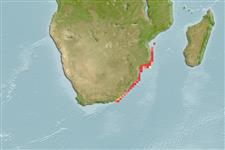Élasmobranches (requins et raies) (sharks and rays) >
Torpediniformes (Electric rays) >
Narkidae (Sleeper rays)
Etymology: Heteronarce: Greek, heteros = other + Greek, narke = numbness (Ref. 45335).
Eponymy: Dr Samuel Trevor Walton Garman (1843–1927) was an American naturalist, most noted as an ichthyologist and herpetologist. [...] (Ref. 128868), visit book page.
More on author: Regan.
Environment: milieu / climate zone / depth range / distribution range
Écologie
marin démersal; profondeur 73 - 329 m (Ref. 6589). Subtropical; 20°S - 35°S, 27°E - 37°E (Ref. 114953)
Western Indian Ocean: southern Mozambique to Algoa Bay, South Africa (Ref. 5578).
Taille / Poids / Âge
Maturity: Lm ? range ? - ? cm
Max length : 25.0 cm TL mâle / non sexé; (Ref. 6589)
Description synthétique
Clés d'identification | Morphologie | Morphométrie
Small ray with an elongated, narrow disc and a small, narrow caudal fin (Ref. 5578). Plain brown above, white below (Ref. 5578).
Found on the outer shelf and upper slope (Ref. 5578). Life history unknown. Males reaches maturity at ca. 17 cm TL (Ref. 114953).
Life cycle and mating behavior
Maturité | Reproduction | Frai | Œufs | Fécondité | Larves
Compagno, L.J.V., 1986. Narkidae. p. 113-114. In M.M. Smith and P.C. Heemstra (eds.) Smiths' sea fishes. Springer-Verlag, Berlin. (Ref. 6589)
Statut dans la liste rouge de l'IUCN (Ref. 130435: Version 2024-1)
Menace pour l'homme
Other
Utilisations par l'homme
Pêcheries: sans intérêt
Outils
Articles particuliers
Télécharger en XML
Sources Internet
Estimates based on models
Preferred temperature (Ref.
123201): 15.2 - 22, mean 18.1 °C (based on 27 cells).
Phylogenetic diversity index (Ref.
82804): PD
50 = 0.5627 [Uniqueness, from 0.5 = low to 2.0 = high].
Bayesian length-weight: a=0.01000 (0.00244 - 0.04107), b=3.04 (2.81 - 3.27), in cm total length, based on all LWR estimates for this body shape (Ref.
93245).
Niveau trophique (Ref.
69278): 3.2 ±0.3 se; based on size and trophs of closest relatives
Résilience (Ref.
120179): Faible, temps minimum de doublement de population : 4,5 à 14 années (Assuming fecundity<100).
Fishing Vulnerability (Ref.
59153): Low vulnerability (15 of 100).
